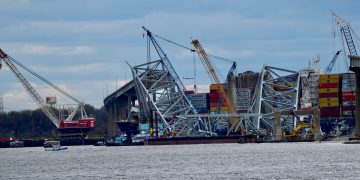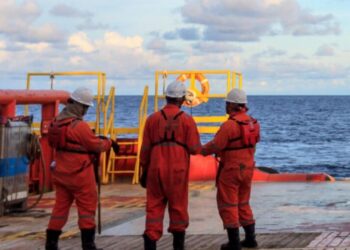The Republic of the Marshall Islands Maritime Administrator has been notified of a marine casualty which occurred aboard an RMI-registered ship and issued marine notice to highlight lessons learned for correct pilot ladder and embarkation ladder markings.
The incident resulted in a surveyor falling four meters and being seriously injured when the side ropes parted on the embarkation ladder he was climbing. The Administrator’s investigation determined the embarkation ladder was a counterfeit. The investigation also determined that the ladder was supplied to the ship by an International Organization for Standardization (ISO) 9001-certified chandler.
Indications that the failed embarkation ladder was a counterfeit included incomplete markings and the use of poor-quality step fixtures.
Manufacturers of pilot ladders are required to certify that pilot ladders comply with the
requirements of the International Convention for the Safety of Life at Sea (SOLAS), regulation V/23.2.3. Embarkation ladders required by SOLAS regulation III/11.7 should comply with the requirements in the International Life-Saving Appliance Code (LSA Code), §6.1.6 or ISO 5489.
On all RMI-registered vessels, the Administrator recommends that each pilot and embarkation ladder be inspected with particular attention given to the markings to determine if they might be counterfeit.
Pilot ladders complying with International Maritime Organization Assembly Resolution A.1045(27) and embarkation ladders complying with the LSA Code, §6.1.6 are not required to be marked. However, if there is any doubt regarding the authenticity of a pilot or embarkation ladder, it should be taken out of service and the manufacturer contacted to determine if it is genuine or a counterfeit.
The chandler or vendor who provided the ladder should not be depended on to verify the authenticity of any questionable ladders. Those confirmed to be counterfeit should be destroyed and replaced with a ladder from a genuine original equipment manufacturer (OEM).
Pilot and embarkation ladders should be obtained from OEMs that can show they
have a certified Quality Management System in place.
When purchasing a pilot or embarkation ladder, care should be exercised that the product supplied meets the applicable requirements. Relying on the OEM’s documentation may not always be sufficient. If in doubt, the ship’s Recognized Organization (RO) should be requested to confirm that the ladder meets the minimum standards.
Pilot and embarkation ladders should be obtained directly from the OEM or a local OEM-approved supplier.
ISO 799:2004 and ISO 799-1:2019 require that the bottom of the top step and the bottom of the lowest spreader step of pilot ladders be marked with:
1. the manufacturer’s name and address;
2. the manufacturer’s model designation;
3. “ISO 799” or “ISO 799-1,” as appropriate, and “SOLAS;”
4. the ladder’s year of assembly or reassembly;
5. identification of the approved maritime safety administration, along with any approval
indications required by that administration; and
6. where used, identification of an approved organization acting on behalf of the maritime
safety administration.
ISO 5489:2008 requires that the bottom of at least two steps of embarkation ladders be marked with:
1. the manufacturer’s name and address;
2. the manufacturer’s model designation;
3. “ISO 5489” and “SOLAS;”
4. the ladder’s year of assembly or reassembly;
5. identification of the approving maritime safety administration, along with any approval
indications required by that administration;
6. where used, identification of an RO acting on behalf of the maritime safety administration

































































